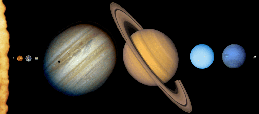
-
Prof: Doug Hamilton
Phone: (301) 405-1548
Email:
Office: PSC 1153
Office Hours: Drop by Anytime!
Textbook: Planetary Sciences by I. de Pater and J.J. Lissauer
Webpage: http://www.astro.umd.edu/~hamilton/ASTR630

This course will survey our Solar System with an emphasis on physical processes that help us understand its origin and connection to other planetary systems. According to the authors of our award-winning textbook "Planetary Sciences," the amount of material in the book "is difficult to cover in a one-year graduate-level course", so we will choose topics selectively to fit into one semester. Topics to be covered in the first two months of the course include orbital dynamics, the physics of planetary atmospheres, and radiative transfer (chapters 1-4). We will emphasize techniques of problem solving and will focus a number of topics including the three-body problem, orbital resonances, hydrostatic equilibrium, equations of state, thermal structure of an atmosphere, and winds.
During the final month of the course we will discuss three additional chapters from the textbook: Meteorites (Ch. 8), Comets (Ch. 10), and Planetary Rings (Ch. 11). Since we will be covering a lot of material in a short amount of time, you will get the most out of class lectures if you read and think critically about the relevant book chapters before we go over them in class. All material from chapters 1-4,8,10, and 11 is fair game for tests.
We will have two in-class midterms, a final exam, and five homework assignments, largely but not exclusively drawn from the text. There will also be a class research project, with abstracts due in the middle of the semester and an oral presentation at the end of the semester. The presentations will be made at the TERPS 2014 Conference, to which the entire department is invited. Giving a talk to a friendly local audience is the best way for you to prepare to give a talk on your own scientific research at a professional meeting.
 Return
to ASTR630 Home Page
Return
to ASTR630 Home Page